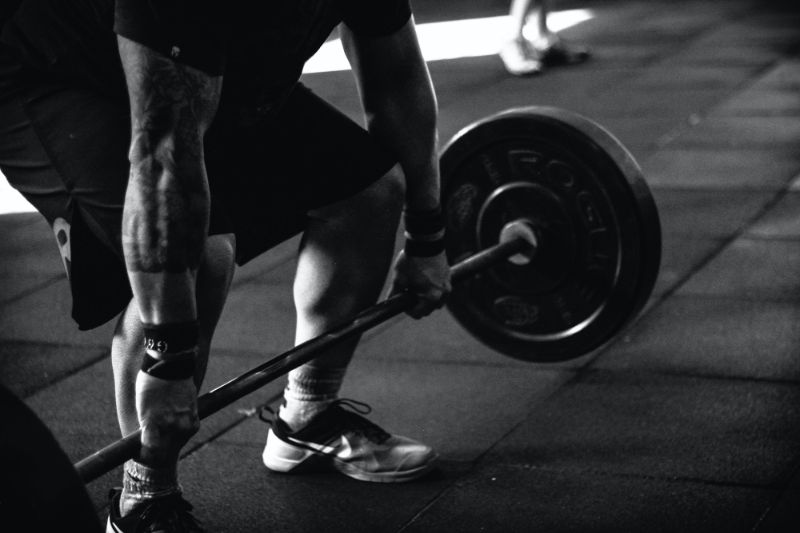
Table of Contents (click to expand)
Starting Your Journey in Weight Lifting
Welcome to the world of lifting weights. If you’re wondering how to start weightlifting, you’ve arrived at the right place. Embarking on a strength training program is a fantastic way to improve your health, build lean muscle mass, and boost your self-confidence. Let’s dive in.
Understanding the Basics of Strength Training
Strength training, often interchangeable with resistance training, refers to exercises designed to increase muscle strength and endurance. The principle behind strength training lies in muscular contraction, which happens when your muscles resist a force.
This force can come in different forms, providing the basis for the various types of strength training. Understanding these other forms of resistance is essential to build a well-rounded strength training program.
Body Weight Exercises
One of the simplest forms of strength training is bodyweight exercises. Here, the resistance is provided by your body weight. Exercises like push-ups, pull-ups, squats, lunges, and planks fall into this category.
These exercises are often the foundation of any strength training program, especially for beginners. They’re beneficial as they mimic natural movements, help improve balance and flexibility, and can be done anywhere with minimal or no equipment.
Free Weights
Free weights refer to objects that aren’t attached to an apparatus. This includes dumbbells, barbells, kettlebells, and weight plates. The resistance, in this case, is the weight of these objects.
Free weight exercises require the engagement of more muscle groups since you also need to stabilize the weight while lifting it. They offer a great way to target specific muscle groups and build muscle mass and strength.
Weight Machines
Weight machines have adjustable seats, pads, and weight stacks. They provide resistance through a system of pulleys and cables. Examples include the leg press machine, chest press machine, and seated row machine.
These machines are typically found in gyms and fitness centers. They’re excellent for beginners as they offer support and guidance in the weight room maintaining proper form and reducing the risk of injury. They also allow you to lift heavier weights and isolate certain muscle groups safely.
Resistance Bands
Resistance bands are elastic bands used for various strength training exercises. The tension in the bands provides resistance. They come in different resistance levels and can add a challenge to traditional body weight exercises or assist with specific activities like pull-ups.
Resistance bands are lightweight, portable, and versatile, making them a great option for home workouts or training while traveling.
Other Forms of Resistance
Other forms of resistance include sandbags, medicine balls, or even everyday household objects. Essentially, anything that forces your muscles to work harder than usual would serve as resistance.
Understanding these basics of strength training can help you create a diverse, effective, and safe exercise program. Always start with what you’re comfortable with and progressively increase the challenge as your strength and confidence grow.
Exploring the Concept of Weight Training
Weight training, a specific form of strength training, centers around lifting weights to build and strengthen various muscle groups within the body. This form of training isn’t just for bodybuilders or professional athletes; it’s an essential component of a balanced fitness routine for people of all fitness levels.
The Fundamentals of Weight Training
At the core of weight training lies the principle of overload, which suggests that muscles must be challenged by working against a weight or force to develop and build muscle mass and strength. Over time, as the muscles adapt to the applied stress, the weight or pressure gradually increases.
In weight training, this overload is typically provided by free weights such as dumbbells, kettlebells, or barbells. However, weight machines and household objects like water jugs can also be used, making weight training a highly versatile and accessible form of exercise.
Benefits of Weight Training
Incorporating weight training workouts into your exercise program can yield many benefits. Some of the primary ones include:
- Increased Muscle Mass and Strength: Weight training stimulates muscle fibers, causing them to grow larger and more robust. This leads to increased muscle mass and strength over time.
- Improved Body Composition: By boosting lean muscle mass, weight training can help improve body composition, reducing body fat percentage and increasing lean body mass. This can result in a more toned and athletic appearance.
- Enhanced Metabolic Rate: Muscle tissue is more metabolically active than fat tissue. This means the more muscle mass you have, the more calories you burn, even at rest. Thus, weight training can help increase your metabolic rate, aiding in weight management.
- Better Bone Health: Weight training is beneficial for bone health as well. Lifting weights applies stress not only on your muscles but also on your bones, which can help increase bone density and reduce the risk of osteoporosis.
- Improved Physical Performance: By increasing muscle strength and endurance, weight training can improve your performance in other physical activities, whether everyday tasks like carrying groceries or recreational activities like hiking or playing sports.
The Practice of Weight Training
The practice of weight training involves performing a variety of exercises that target different muscle groups. A typical weight training workout might include exercises per muscle group, such as bicep curls, bench presses, squats, deadlifts, and shoulder presses.
For optimal results, it’s crucial to use the proper technique, maintain a balanced program that targets all major muscle groups, and follow a progressive approach, gradually increasing the weight or resistance as your strength improves.
Additionally, pairing your weekly weight training schedule with adequate recovery time, proper nutrition, and balanced cardio workouts is essential. While it’s possible to start weight training independently, many beginners find it helpful to work with a personal trainer to learn proper form and establish a program that meets their specific goals and needs.
Understanding the concept and benefits of weight training can be the first step towards integrating this valuable form of exercise into your fitness routine.
Differentiating Strength Training, Weight Training, and Body Weight Exercises
While weight training involves lifting weights, strength training is a broader concept that includes body-weight exercises such as push-ups and squats. These exercises use your body weight as resistance, providing a fantastic starting point if you want to start weight and strength training workouts.
Preparing to Start Lifting Weights
Mental readiness is an often overlooked yet crucial component of a successful weight training journey. Building the mental strength to commit to a regular workout schedule, push through challenging exercises, and overcome inevitable plateaus is as important as building physical strength. Here’s why:
- Discipline and Consistency: Mental readiness fosters discipline, critical to maintaining a consistent workout schedule. It’s easy to be motivated in the first few weeks of a new routine, but the field will keep you going when the novelty wears off.
- Overcoming Challenges: Weight training can be challenging, both physically and mentally. There will be days when lifting a certain weight feels impossible. Mental toughness will help you push through these difficult days and become more assertive on the other side.
- Managing Expectations: It’s crucial to understand that progress in weight training often takes time. Mental readiness helps manage expectations and cultivates patience, allowing you to appreciate the small victories along your journey.
- Positive Self-Talk: Positive self-talk can significantly influence your performance and enjoyment of weight training. Instead of focusing on how hard an exercise is, remind yourself of your strength and how far you’ve come.
Physical Preparation: Before You Start Lifting Weights
Proper physical preparation is critical to a safe and effective workout. BeforeBefore starting any weight lifting routine, performing a light cardio warm-up is essential. This could be a brisk walk, a slow jog, or jumping jacks—anything that gets your heart rate up and your muscles warm. Warming up increases blood flow to your muscles, preparing them for strenuous activity and reducing the risk of injury.
Seeking Medical Advice Before Weight Training
Before starting any new exercise regimen, mainly as demanding as weight training, it’s wise to consult a healthcare professional. This is especially important if you’re over 40, have been sedentary for a long time, have any underlying health conditions, or are pregnant. Your doctor or a sports medicine professional can evaluate your overall health and provide guidelines to ensure you exercise safely.
The Role of Diet in Strength Training
When it comes to strength training, nutrition is half the battle. A balanced diet is vital to fuel your workouts and aid in muscle recovery and growth. Here are the primary components:
- Protein: Protein is crucial for muscle repair and growth. Aim to include a good source of protein in each meal. Lean meats, fish, eggs, dairy products, legumes, and plant-based proteins are excellent choices.
- Carbohydrates: Carbs are your body’s primary source of energy. They’re essential on heavy training days to fuel your workouts. Opt for complex carbs like whole grains, fruits, and vegetables for sustained energy.
- Healthy Fats: Fats are essential for hormone production and can serve as fuel during workouts. Include sources of healthy fats in your diet, like avocados, nuts, seeds, and fatty fish.
- Hydration: Staying well-hydrated is crucial for overall health and optimal athletic performance. Hydration aids in nutrient transport, muscle recovery, and maintaining energy levels.
Remember, nutrition needs can vary significantly based on individual goals, body composition, and level of physical activity. Consulting with a registered dietitian can help you develop a personalized nutrition plan that aligns with your strength training goals.
The Significance of Body Weight Training
Body weight training uses your own body weight as resistance and is a great way to start weight training. It involves push-ups, squats, and lunges targeting multiple muscle groups.
Body Weight Exercises to Start With
If you’re just starting, certain exercises like squats, push-ups, and lunges can help build strength before lifting weights.
Progressing with Body Weight Training
As you get stronger, you can make these exercises more challenging by adding variations or increasing the number of reps you perform.
Graduating from Body Weight Training to Weight Lifting
Once you’re comfortable with bodyweight exercises, you may want to transition to lifting weights. Start with lighter weights and gradually add more weight as your strength improves.
Understanding the Basics: How to Start Lifting Weights
When you start lifting weights, learning the proper form is crucial. Working with a personal trainer or coach can help ensure you do the exercises correctly.
Equipment Needed for Weight Lifting
When it comes to weight lifting, you’ll need some essential equipment. This includes dumbbells, barbells, weight plates, and potentially a weight bench or squat rack.
Basic Weight Lifting Techniques to Learn
Learning how to lift weights correctly is crucial to prevent injury and make the most of your workouts. Some basic techniques include doing a squat, deadlift, and bench press.
Common Mistakes Beginners Make in Weight Lifting
Common mistakes include lifting too much weight too soon, not using the proper form, and not giving your muscles enough time to rest between workouts.
How to Develop Your First Weight Training Program
Creating a strength training program can be overwhelming if you’re new to weight lifting. That’s where a certified personal trainer can help. They can design a program that suits your fitness level and goals.
Importance of a Structured Weight Training Routine
Having a structured weight training plan and routine is crucial. It helps you stay consistent, tracks your progress, and ensures you’re working all your muscle groups evenly.
Creating a Balance: Strength Training and Rest Days
Rest days are just as important as your workout days. They give your muscles a chance to repair and grow stronger.
Adapting Your Program as Your Strength Increases
As you get stronger, you’ll need to adjust your program to continue making progress. This could involve lifting weights, doing more reps or sets, or trying different exercises.
Key Exercises for Weight Training Beginners
Starting with basic exercises like squats, bench presses, and deadlifts can help you build muscle and foundational strength. Each of these exercises targets multiple muscle groups, providing a comprehensive workout.
Understanding and Executing Deadlifts
Deadlifts are a fantastic exercise that works your entire body. Start with your feet hip-width apart, slowly bend over at the hips and knees, and grasp the barbell with your hands shoulder-width apart. Keep a neutral spine as you lift the barbell, then slowly return to the starting position.
Mastering the Art of Squats
Squats are lower-body exercises that target your quadriceps, hamstrings, and glutes. Start with your feet shoulder-width apart, bend your knees, and lower your body as if sitting in a chair. Push through your heels to return to the starting position.
Benefits and Techniques of the Bench Press
The bench press is a fantastic exercise for your chest, shoulders, and triceps. Start by lying on a bench, feet flat on the floor, and arms straight out. With a dumbbell in each hand, lower the weights until your elbows are 90 degrees, then push back up to the starting position.
The Importance of Proper Form in Weight Training
Proper form is crucial when you’re lifting weights. Not only does it ensure you’re working the right muscle groups, but it also helps prevent injuries. Always perform exercises slowly and with control.
Common Weight Lifting Injuries and How to Avoid Them
Common injuries from weight lifting include sprains, strains, and dislocations. Avoid these by warming up properly, using the correct form, and not lifting more weight than you can handle.
The Role of Warm-ups and Cool-downs in Lifting Weights
Warm-ups and cool-downs are essential parts of any workout. A warm-up helps increase blood flow to your muscles and prepares your body for the upcoming workout. A cool-down helps return your heart rate to normal and aids recovery.
Understanding and Overcoming Weight Training Plateaus
Plateaus can happen when your body gets used to the same exercises and weight. Overcoming a plateau can involve changing your exercises, increasing your weights, or altering the number of sets and reps you do.
The Role of Progressive Overload in Strength Training
Progressive overload involves gradually increasing the stress you put on your muscles during a workout. This can involve lifting heavier weights, doing more reps, or exercising slowly, increasing your number of sets.
When and How to Increase Weight in Lifting Weights
When you can comfortably perform the maximum number of recommended reps for an exercise, it’s time to add weight. Increase the weight slowly to ensure you can maintain proper form.
The Importance of Nutrition in Weight Lifting
Nutrition plays a crucial role in weightlifting. The right nutrients help fuel your workouts and promote muscle repair and recovery.
Understanding the Role of Protein in Muscle Building
Protein is vital for building and repairing muscle fibers damaged during workouts. Aim for a source of protein in every meal, including lean meats, dairy, and legumes.
Hydration and Its Significance in Weight Training
Staying hydrated is essential during weight training. Water helps regulate your body temperature, keeps your joints lubricated, and transports nutrients to give you energy and keep you healthy.
Staying Motivated in Your Weight Training Journey
Keeping your motivation high is crucial in your weight training journey. Set realistic goals, track your progress, and don’t forget to celebrate your achievements.
Seeking Professional Help: Coaches and Trainers
Working with a NASM-certified personal trainer can be beneficial, especially if you’re new to weight lifting. They can guide proper form, help you create a personalized strength training program, and motivate you.
Importance of Recovery in Strength Training
Recovery is key in strength training. This includes rest days, adequate sleep, and proper nutrition. It allows your muscles to heal and grow stronger.
Balancing Weight Training with Other Forms of Exercise
Including other forms of exercise in your routine, such as aerobic exercise or yoga, can help enhance your overall fitness and prevent burnout.
How Should Beginners Start Lifting?
For beginners, the safest and most effective way to start lifting weights is gradually and under guidance. Here are some steps to get started:
- Learn the Basics: Start by learning about different types of strength training, the benefits of weight lifting, and the importance of proper form and technique.
- Consult a Professional: Consider hiring a certified personal trainer or enrolling in a beginner’s weightlifting class. They can teach you the correct form, guide you through exercises, and help you establish a routine.
- Begin with Light Weights: Start with lighter weights and focus on learning the proper form. As you become more comfortable, gradually increase your weight.
- Full-Body Workouts: Initially, aim for full-body workouts that target all major muscle groups. This helps ensure balanced development.
- Rest and Recover: Remember, muscles grow during rest, not while lifting. Aim for at least one full rest day between workouts.
- Listen to Your Body: Pay attention to how your body responds. If you feel pain or discomfort, stop. It’s okay to take it slow and progress at your own pace.
When Should a Beginner Start Lifting Weights?
There is no set age or fitness level when a beginner should start lifting weights. If you’re physically healthy and have received clearance from a healthcare provider, you can start lifting weights. However, starting slowly, using light weights, and learning proper form to prevent injuries are crucial.
For adolescents interested in weightlifting, it’s recommended they have supervision to ensure safe practices. Younger children can focus on bodyweight exercises and physical activities that naturally build strength, like climbing, jumping, or gymnastics.
What is a Beginner in Weightlifting?
A beginner in weightlifting is typically someone new to lifting weights. This individual may have little experience performing exercises involving free weights, weight machines, or resistance bands.
Beginners are often learning the correct form for specific exercises first, familiarizing themselves with different types of equipment and establishing their initial strength baseline. It’s common for beginners to start with lighter weights and gradually increase the weight as their strength and confidence grow.
How Much Weight Should I Lift for My Size?
The amount of weight you should lift doesn’t directly correlate to your size but rather your strength level and the specific exercise you’re performing. As a general rule, you should use a weight that challenges you but one that doesn’t compromise your form.
A good starting point for beginners is to choose a weight that allows you to perform 12-15 reps of an exercise with proper form. The last few reps should be challenging but not so hard that you can’t complete them or have to sacrifice your form.
As you gain strength, you’ll be able to lift heavier weights. Always prioritize form over the amount of weight, and don’t rush the process. Lifting lighter weights in perfect condition is better than lifting heavier weights incorrectly or unsafely.
Everyone is unique, and what works for one person might not work for another. Listening to your body and seeking guidance from a personal trainer or coach is crucial to ensure you’re lifting the right weight for your strength level and goals.
Reviewing the Journey: How to Start Lifting
Learning to lift weights can feel overwhelming, but you can confidently begin your weight training journey with the correct information and support. Remember to start to slow, prioritize proper form, and listen to your body.
Embracing the Lifelong Commitment to Strength Training
Strength training is a lifelong commitment but has numerous physical and mental health benefits. So pick up those weights, and embrace the journey to a stronger, healthier you.
Remember, the key is consistency, proper nutrition, and adequate rest. All the best on your weight training journey!





































